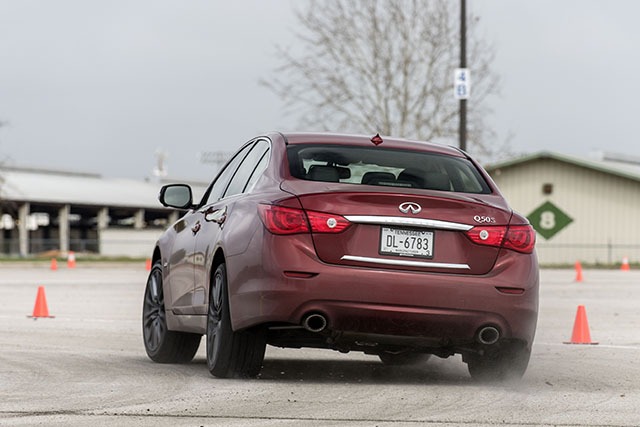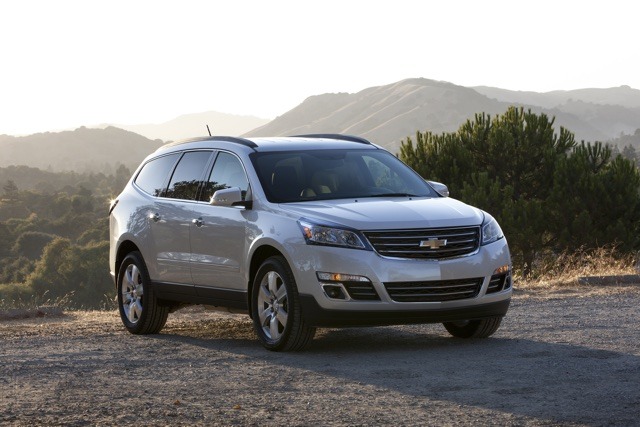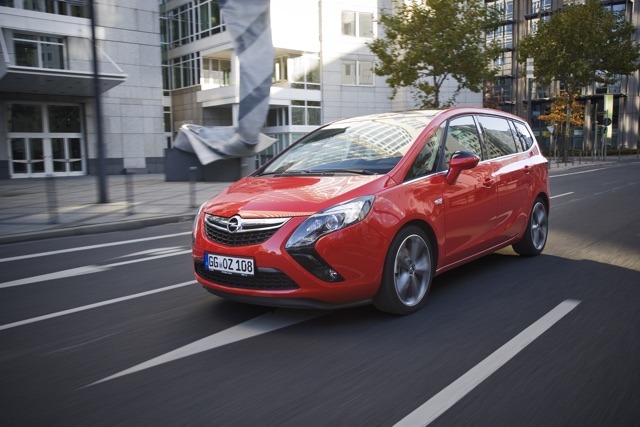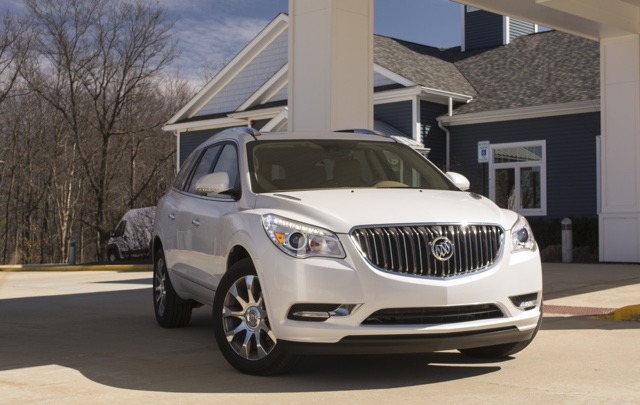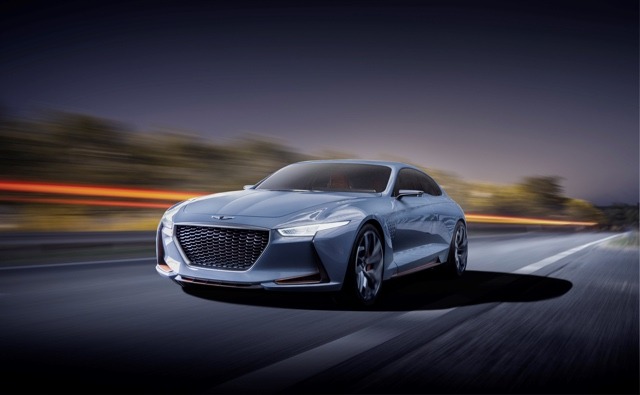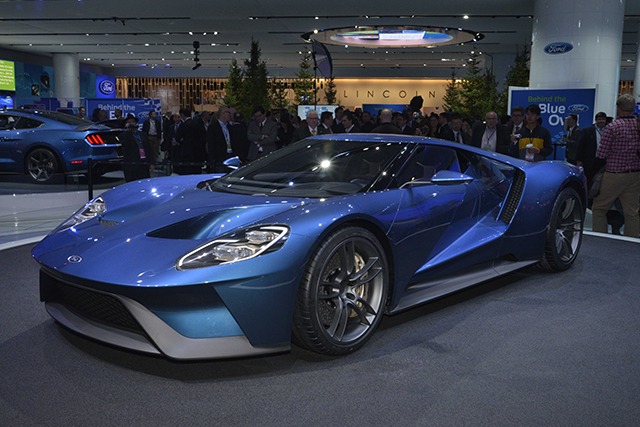-
Posts
32,884 -
Joined
-
Last visited
-
Days Won
5
Content Type
Forums
Articles
Garage
Gallery
Events
Store
Collections
Everything posted by William Maley
-
Infiniti and high-performance vehicles just never seem to happen. We hear about plans and see concepts that preview an upcoming model. Then, the plans fall through. The latest victim was the Q50 Eau Rouge concept that was officially canceled last year. Still, Infiniti isn't giving up the dream. Infiniti's European boss François Goupil de Bouille tells Autocar that the brand knows it needs a halo vehicle (such as performance model) and hinted that hybrid power could be used for it. “Having halo cars is important, but historically brands develop their base and then add in these higher-end models. One day the question will come for Infiniti, but at the moment our focus is on building the core," Goupil de Bouille said. (In terms of Europe, not North America. -WM) “But if you look at what we are doing in F1 then you can see some possibilities. We worked closely with Red Bull, but now with Renault we are more integrated than ever and have taken charge of the hybrid modules on the F1 car. That gives an idea of the direction in which we are going in terms of performance and, while no decisions have been taken for road cars, when we are ready to discuss it, there is one opportunity there.” But like previous times with any talk of an Infiniti performance vehicle, we'll believe when we see it. Source: Autocar
- 3 comments
-
- Halo
- High-Performance
-
(and 3 more)
Tagged with:
-
Earlier this week, we reported that General Motors was working on a compensation plan for owners of 2016 Buick Enclave, Chevrolet Traverse, and GMC Acadia crossovers that had inflated fuel economy numbers. Yesterday, the company unveiled the plan. Automotive News and Reuters reports that GM will offer buyers the choice of either debit card (ranging from $450 to $1,500) or a 48 month/60,000 mile extended warranty. Those who are leasing the crossovers in question will only get the debit card. The amount a person will get will vary due to various factors including the difference between the inflated and actual fuel economy figures. “We want all of our customers to have a great ownership experience, so we designed this reimbursement program to provide full and fair compensation in a simple, flexible and timely manner,” said a GM spokesman in a statement. How much will this cost GM? A source tells Reuters that it will be about $100 million. Source: Automotive News (Subscription Required), Reuters View full article
- 10 replies
-
- Compensation
- Crossovers
-
(and 3 more)
Tagged with:
-

General Motors Details Compensation Plan For Crossover Owners
William Maley posted an article in General Motors
Earlier this week, we reported that General Motors was working on a compensation plan for owners of 2016 Buick Enclave, Chevrolet Traverse, and GMC Acadia crossovers that had inflated fuel economy numbers. Yesterday, the company unveiled the plan. Automotive News and Reuters reports that GM will offer buyers the choice of either debit card (ranging from $450 to $1,500) or a 48 month/60,000 mile extended warranty. Those who are leasing the crossovers in question will only get the debit card. The amount a person will get will vary due to various factors including the difference between the inflated and actual fuel economy figures. “We want all of our customers to have a great ownership experience, so we designed this reimbursement program to provide full and fair compensation in a simple, flexible and timely manner,” said a GM spokesman in a statement. How much will this cost GM? A source tells Reuters that it will be about $100 million. Source: Automotive News (Subscription Required), Reuters- 10 comments
-
- Compensation
- Crossovers
-
(and 3 more)
Tagged with:
-
It seems a week can't go by without another automaker being embroiled in either a fuel economy or emission mess. This week, the German Government has requested Opel to provide more information on a piece of software that turns off the emission controls in the Zafira. The issue at hand is whether or not this software violates regulations. "Shut-off devices are fundamentally illegal, unless it is truly necessary to safeguard the engine," said Alexander Dobrindt, Germany's transport minister after a meeting with Opel to discuss this issue. "Therefore it's clear that in this situation, we have our doubts." This meeting comes after a joint investigation between Spiegel magazine, ARD television's Monitor program and the Deutsche Umwelthilfe environmentalist group. The investigation found software used in the Insignia and Zafira that would turn off emission controls under various conditions such as going above 90 mph. Opel went on the defensive, saying the conclusion was wrong. "We at Opel don't have any illegal software," said Opel president Karl-Thomas Neumann in a statement on Tuesday. Opel explained they do have software that can turn off the emission controls at high speeds, but this was only done to protect the engine. The automaker says this software is legal. But the committee who is looking into this issue has their doubts. "The investigating committee has doubts about whether this practice is completely justified by the protection of the engine," said Dobrindt. Opel has promised to cooperate with the investigation. The committee gave the automaker 14 days to provide technical information on the software. Dobrindt said he would ask other automakers if they use something similar to Opel's software. Source: Automotive News (Subscription Required), Reuters View full article
- 12 replies
-
- Emissions
- Emissions Device
-
(and 4 more)
Tagged with:
-
It seems a week can't go by without another automaker being embroiled in either a fuel economy or emission mess. This week, the German Government has requested Opel to provide more information on a piece of software that turns off the emission controls in the Zafira. The issue at hand is whether or not this software violates regulations. "Shut-off devices are fundamentally illegal, unless it is truly necessary to safeguard the engine," said Alexander Dobrindt, Germany's transport minister after a meeting with Opel to discuss this issue. "Therefore it's clear that in this situation, we have our doubts." This meeting comes after a joint investigation between Spiegel magazine, ARD television's Monitor program and the Deutsche Umwelthilfe environmentalist group. The investigation found software used in the Insignia and Zafira that would turn off emission controls under various conditions such as going above 90 mph. Opel went on the defensive, saying the conclusion was wrong. "We at Opel don't have any illegal software," said Opel president Karl-Thomas Neumann in a statement on Tuesday. Opel explained they do have software that can turn off the emission controls at high speeds, but this was only done to protect the engine. The automaker says this software is legal. But the committee who is looking into this issue has their doubts. "The investigating committee has doubts about whether this practice is completely justified by the protection of the engine," said Dobrindt. Opel has promised to cooperate with the investigation. The committee gave the automaker 14 days to provide technical information on the software. Dobrindt said he would ask other automakers if they use something similar to Opel's software. Source: Automotive News (Subscription Required), Reuters
- 12 comments
-
- Emissions
- Emissions Device
-
(and 4 more)
Tagged with:
-
Last week, General Motors issued a stop sale on the 2016 Buick Enclave, Chevrolet Traverse, and GMC Acadia due to the window stickers having overstated fuel economy numbers by one to two mpg. All-wheel drive models had an incorrect label showing ratings of 17 City/24 Highway/19 Combined. The correct label has ratings of 15 City/22 Highway/17 Combined. But what about the folks who bought one of GM's large crossovers with the incorrect ratings? How did this happen in the first place? We have answers. In a statement to Automotive News, GM explained the 2016 models were equipped with new “emissions-related hardware,” which meant new tests needed to be done. “The fuel economy data from these tests were not captured in calculations made for EPA fuel economy labels ... causing 2016 model year fuel economy numbers to be overstated,” said GM. The error was found when engineers were working on the labels for the 2017 models. This issue was immediately reported to EPA. At the moment, GM is working with the EPA on this issue. As for what will happen to the nearly 170,000 owners of affected crossovers, GM is working on a compensation plan. Sources tell Reuters that GM is working out a program to compensate owners for the difference in fuel economy figures. Out of the 170,000 owners, more than 130,000 will qualify for the program (the remainder of vehicles belong to fleets). The plan will be announced in the coming week. Not surprisingly, an owner of one of the affected models has filed a class-action lawsuit against GM, alleging that the company concealed the actual fuel economy figures. Source: Automotive News (Subscription Required), Reuters Pic Credit: William Maley for Cheers & Gears View full article
- 8 replies
-
- Buick Enclave
- Chevrolet Traverse
- (and 5 more)
-
Last week, General Motors issued a stop sale on the 2016 Buick Enclave, Chevrolet Traverse, and GMC Acadia due to the window stickers having overstated fuel economy numbers by one to two mpg. All-wheel drive models had an incorrect label showing ratings of 17 City/24 Highway/19 Combined. The correct label has ratings of 15 City/22 Highway/17 Combined. But what about the folks who bought one of GM's large crossovers with the incorrect ratings? How did this happen in the first place? We have answers. In a statement to Automotive News, GM explained the 2016 models were equipped with new “emissions-related hardware,” which meant new tests needed to be done. “The fuel economy data from these tests were not captured in calculations made for EPA fuel economy labels ... causing 2016 model year fuel economy numbers to be overstated,” said GM. The error was found when engineers were working on the labels for the 2017 models. This issue was immediately reported to EPA. At the moment, GM is working with the EPA on this issue. As for what will happen to the nearly 170,000 owners of affected crossovers, GM is working on a compensation plan. Sources tell Reuters that GM is working out a program to compensate owners for the difference in fuel economy figures. Out of the 170,000 owners, more than 130,000 will qualify for the program (the remainder of vehicles belong to fleets). The plan will be announced in the coming week. Not surprisingly, an owner of one of the affected models has filed a class-action lawsuit against GM, alleging that the company concealed the actual fuel economy figures. Source: Automotive News (Subscription Required), Reuters Pic Credit: William Maley for Cheers & Gears
- 8 comments
-
- Buick Enclave
- Chevrolet Traverse
- (and 5 more)
-
By 2020, Genesis will have six models in its lineup. We already have seen the G80 and G90 due out later this year, and gotten a sneak peek into the compact G70 sedan. There's also two SUVs and a new coupe. But we didn't know when these models would be coming out until a slide was leaked out. The Korean Car Blog got their hands on an image showing off a presentation slide with a roadmap of their models. We're assuming this is from a meeting with dealers getting briefed on the Genesis brand. The first interesting thing of note deals with the G70. We thought it was still a couple of years out, but the slide shows that it will be at dealers next year. Next are the two SUVs. Genesis looks to be offering a compact and midsize SUV, with the midsize arriving first. The Korean Car Blog speculates it could be as early as 2018. Then we get to the coupe arriving by 2020. It's assumed that it will be based on the G70 sedan, but no details have appeared on this. Source: The Korean Car Blog View full article
-
By 2020, Genesis will have six models in its lineup. We already have seen the G80 and G90 due out later this year, and gotten a sneak peek into the compact G70 sedan. There's also two SUVs and a new coupe. But we didn't know when these models would be coming out until a slide was leaked out. The Korean Car Blog got their hands on an image showing off a presentation slide with a roadmap of their models. We're assuming this is from a meeting with dealers getting briefed on the Genesis brand. The first interesting thing of note deals with the G70. We thought it was still a couple of years out, but the slide shows that it will be at dealers next year. Next are the two SUVs. Genesis looks to be offering a compact and midsize SUV, with the midsize arriving first. The Korean Car Blog speculates it could be as early as 2018. Then we get to the coupe arriving by 2020. It's assumed that it will be based on the G70 sedan, but no details have appeared on this. Source: The Korean Car Blog
-
So you didn't get a Ford GT, but there is a chance you can experience the GT's EcoBoost engine. Dave Pericak. director of Ford Performance told Autocar since the engine has proven itself on the racetrack and there is the possibility of this engine ending up in some low-volume production sports cars. “The engine won at the [2014] 12 Hours of Sebring in the Ford EcoBoost race car, and it’s shown promise in the GT race car already. It shows how capable the engine is,” said Pericak. When asked if the engine could end up in other race cars, Pericak said this was a possibility. He went on to say there was no reason this engine could end up in some low-volume sports or supercar. Currently, Ford does offer the 3.5L EcoBoost as a crate engine with 365 horsepower. Judging from Pericak's comments, there could be the chance of an over 600 horsepower version available as a crate engine. Source: Autocar
-
- 3.5L EcoBoost V6
- Applications
-
(and 4 more)
Tagged with:
-
So you didn't get a Ford GT, but there is a chance you can experience the GT's EcoBoost engine. Dave Pericak. director of Ford Performance told Autocar since the engine has proven itself on the racetrack and there is the possibility of this engine ending up in some low-volume production sports cars. “The engine won at the [2014] 12 Hours of Sebring in the Ford EcoBoost race car, and it’s shown promise in the GT race car already. It shows how capable the engine is,” said Pericak. When asked if the engine could end up in other race cars, Pericak said this was a possibility. He went on to say there was no reason this engine could end up in some low-volume sports or supercar. Currently, Ford does offer the 3.5L EcoBoost as a crate engine with 365 horsepower. Judging from Pericak's comments, there could be the chance of an over 600 horsepower version available as a crate engine. Source: Autocar View full article
-
- 3.5L EcoBoost V6
- Applications
-
(and 4 more)
Tagged with:
-
Volvo has unveiled two new concepts that show what the future of their small cars will look like. Called the 40 Series concepts, Volvo says these show what is in store in terms of design and technology. The 40.1 is likely the preview to the XC40 crossover and the 40.2 is sneak peek into the next S40 sedan. Both concepts feature a number of design cues that we have seen on the XC90 and S90 such as 'Thor's Hammer' daytime running lights and wide grille. Both concepts use the new Compact Modular Architecture (CMA) that was jointly developed by Volvo and Geely. This platform will underpin Volvo's future small car lineup including a new electric vehicle. A range of three and four-cylinder engines will be on offer, along with a plug-in hybrid called the T5 Twin Engine. Surprisingly, the T5 Twin Engine will only be front-wheel drive. The T8 Twin Engine comes only in all-wheel drive. A new seven-speed dual-clutch will be paired with all of the engines. The good news is that Volvo will offer the 40 Series in the U.S. As to when we'll be seeing the production versions, the first model will come out in 2017. Many expect it to be the XC40, followed by the S40 and V40 hatchback. Source: Volvo Press Release is on Page 2 Volvo provides the first look at its new range of smaller cars Volvo Cars, the premium car maker, today unveiled two new concept cars that move the Swedish brand in an audacious new direction and mark the official launch of its global small car strategy. Today’s newly-revealed 40 series concepts demonstrate for the first time how Volvo plans to expand into the large and lucrative global market for premium small cars with a range of vehicles that combine bold exterior and interior design with industry-leading connectivity, electrification and autonomous drive technologies. The new concept cars will be the first built around Volvo’s new Compact Modular Architecture (CMA), which has been specially created for smaller cars and which has liberated the company’s designers and engineers to explore bold and daring new directions. “Each member of our product family has its own distinct character, just like the members of a real family. CMA has helped us to capture something special, something youthful in our new concept cars. They have an energy, a disruptive and engaging urban character that makes them stand out amongst the crowd. This is the flavour of small Volvos to come,” said Thomas Ingenlath, Senior Vice President, Design, at Volvo Car Group. Volvo’s small car strategy is an essential element in its ongoing global operational and financial transformation. The Swedish company is currently implementing an ambitious revitalisation plan that will reposition the brand to compete with its global premium competitors within the next four years. Volvo’s new global small car range will include a pure battery electric vehicle as well as Twin Engine plug-in hybrid powertrain variants, in line with the company’s commitment to the electrification of its entire portfolio. Volvo plans to have sold a total of up to 1 million electrified cars by 2025 globally. “By taking a modular approach to both vehicle architecture and powertrain development we have succeeded in leap-frogging many of the players in the premium segment,” said Dr Peter Mertens, Senior Vice President Research & Development. “Our new battery electric powertrain variant opens yet another exciting chapter in the unfolding Volvo story.” On top of their daring exterior design and electrified powertrain options, the new cars will also offer a full range of innovative connectivity services, plus the world’s most advanced standard package of safety features and ground breaking Scandinavian interior design. “The new 40 series cars have the potential to improve our market penetration in an important growing segment,” said Håkan Samuelsson, president and chief executive. “An electric powertrain program including both a new compact Twin Engine plug-in hybrid as well as a pure electric car are central to the CMA architecture.” He added that the first new 40 series car is expected to go into production in 2017. View full article
- 3 replies
-
- 40 Series Concepts
- 40.1 Concept
-
(and 3 more)
Tagged with:
-

Volvo's 40 Series Concepts Show the Future of Their Small Cars
William Maley posted an article in Volvo
Volvo has unveiled two new concepts that show what the future of their small cars will look like. Called the 40 Series concepts, Volvo says these show what is in store in terms of design and technology. The 40.1 is likely the preview to the XC40 crossover and the 40.2 is sneak peek into the next S40 sedan. Both concepts feature a number of design cues that we have seen on the XC90 and S90 such as 'Thor's Hammer' daytime running lights and wide grille. Both concepts use the new Compact Modular Architecture (CMA) that was jointly developed by Volvo and Geely. This platform will underpin Volvo's future small car lineup including a new electric vehicle. A range of three and four-cylinder engines will be on offer, along with a plug-in hybrid called the T5 Twin Engine. Surprisingly, the T5 Twin Engine will only be front-wheel drive. The T8 Twin Engine comes only in all-wheel drive. A new seven-speed dual-clutch will be paired with all of the engines. The good news is that Volvo will offer the 40 Series in the U.S. As to when we'll be seeing the production versions, the first model will come out in 2017. Many expect it to be the XC40, followed by the S40 and V40 hatchback. Source: Volvo Press Release is on Page 2 Volvo provides the first look at its new range of smaller cars Volvo Cars, the premium car maker, today unveiled two new concept cars that move the Swedish brand in an audacious new direction and mark the official launch of its global small car strategy. Today’s newly-revealed 40 series concepts demonstrate for the first time how Volvo plans to expand into the large and lucrative global market for premium small cars with a range of vehicles that combine bold exterior and interior design with industry-leading connectivity, electrification and autonomous drive technologies. The new concept cars will be the first built around Volvo’s new Compact Modular Architecture (CMA), which has been specially created for smaller cars and which has liberated the company’s designers and engineers to explore bold and daring new directions. “Each member of our product family has its own distinct character, just like the members of a real family. CMA has helped us to capture something special, something youthful in our new concept cars. They have an energy, a disruptive and engaging urban character that makes them stand out amongst the crowd. This is the flavour of small Volvos to come,” said Thomas Ingenlath, Senior Vice President, Design, at Volvo Car Group. Volvo’s small car strategy is an essential element in its ongoing global operational and financial transformation. The Swedish company is currently implementing an ambitious revitalisation plan that will reposition the brand to compete with its global premium competitors within the next four years. Volvo’s new global small car range will include a pure battery electric vehicle as well as Twin Engine plug-in hybrid powertrain variants, in line with the company’s commitment to the electrification of its entire portfolio. Volvo plans to have sold a total of up to 1 million electrified cars by 2025 globally. “By taking a modular approach to both vehicle architecture and powertrain development we have succeeded in leap-frogging many of the players in the premium segment,” said Dr Peter Mertens, Senior Vice President Research & Development. “Our new battery electric powertrain variant opens yet another exciting chapter in the unfolding Volvo story.” On top of their daring exterior design and electrified powertrain options, the new cars will also offer a full range of innovative connectivity services, plus the world’s most advanced standard package of safety features and ground breaking Scandinavian interior design. “The new 40 series cars have the potential to improve our market penetration in an important growing segment,” said Håkan Samuelsson, president and chief executive. “An electric powertrain program including both a new compact Twin Engine plug-in hybrid as well as a pure electric car are central to the CMA architecture.” He added that the first new 40 series car is expected to go into production in 2017.- 3 comments
-
- 40 Series Concepts
- 40.1 Concept
-
(and 3 more)
Tagged with:
-
From the album: Volvo 40 Series Concept
-
From the album: Volvo 40 Series Concept
-
From the album: Volvo 40 Series Concept
-
From the album: Volvo 40 Series Concept
-
From the album: Volvo 40 Series Concept
-
From the album: Volvo 40 Series Concept
-
From the album: Volvo 40 Series Concept
-
From the album: Volvo 40 Series Concept
-
From the album: Volvo 40 Series Concept
-
From the album: Volvo 40 Series Concept
-
From the album: Volvo 40 Series Concept



